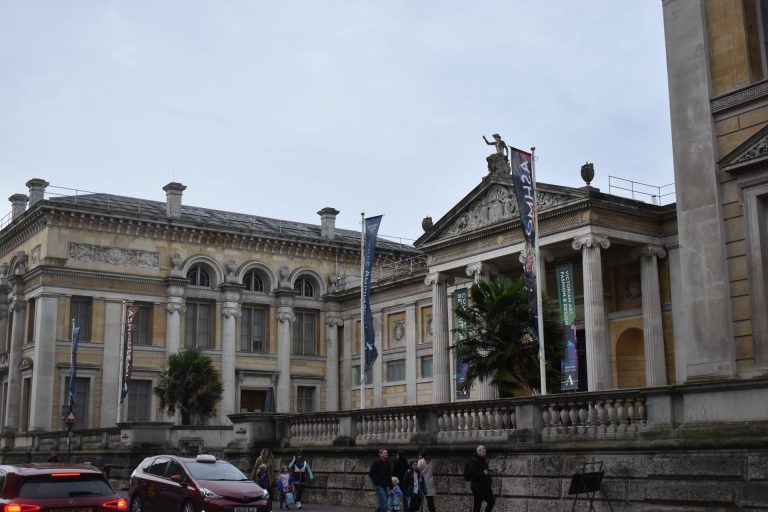Rory Stewart has been an academic, podcaster, writer, diplomat and politician. He read PPE at Balliol. While an undergraduate, he tutored Princes William and Harry, and attended a meeting of the Bullingdon Club. He has written several acclaimed books, including Occupational Hazards, an account of his time as a governor in Iraq; and Politics on the Edge, a memoir of his parliamentary career spanning 2010-2019. In government he served in various positions, including Prisons Minister, and in 2019 was a frontrunner for the Conservative leadership contest won by Boris Johnson, of whom Stewart remains a critic. He has also written travel books, The Marches and The Places in Between. Since 2022 he has co-hosted, with Alastair Campbell, the immensely successful podcast “The Rest is Politics”. Cherwell sat down with him to discuss his opinions on the US election, populism, the Starmer government, the prison system, and his personal goals for the future
Cherwell: Was there anything in your early life which foreshadowed your later career?
Stewart: I was very interested in travelling when I was young. A lot of my strongest memories are of spending time, for example, in Borneo when I was eleven, and again in Malaysia when I was eight, and Thailand when I was fifteen, and in Xinjiang, China when I was sixteen or seventeen. They had a deep impact on me. I have boys who are seven and ten and we’ve just been travelling in Afghanistan together, and I’ve been very struck there by getting a sense of what they notice and what they do and don’t notice. One thing that’s very striking is how attractive jungles and rainforests are. Watching my seven-year-old walk along the paths and watch the birds, tress, flowers and nuts, reminded me a lot of being that age.
Cherwell: When you were nineteen you came up to Balliol. Do you have a memorable tutorial moment from your undergraduate years?
Stewart: I had a tutor called Martin Conway who was a History tutor at Balliol. I remember very strongly doing the Spanish Civil War with him, and realising that the story of why Franco won the war was almost a village-by-village, town-by-town story. It was almost a question of a million tiny events, almost unpredictable flips, 51-49, in tiny communities that won it. We often forget that looking back at history. We imagine there are big single causes driving things. It struck me how often these are often close-run things, how they are very contingent, and how the great causes are things that we read back into them. I feel that way about the US election at the moment. It’s very tempting to say, This result is because of two or three main things, but what strikes me is that it’s 70 million people and individual minds in each ballot, with a wide variety of knowledge and beliefs. The process of simplification in history is misleading. It’s one of the things that made me change from History to Philosophy at Oxford. I became very confused by what it really meant to as a question like “What were the causes of the First World War?” It seemed to me that almost every event which preceded the First World War was a cause of it.
Cherwell: What did you think of the Oxford Union?
Stewart: I didn’t like the Oxford Union, not my kind of thing, no.
Cherwell: Did you read Cherwell?
Stewart: I did, I enjoyed reading Cherwell, yes.
Cherwell: You’ve mentioned that you attended a Bullingdon Club event once. How was that?
Stewart: I didn’t like it, I didn’t like the tone of it. I don’t know what it’s like now but, then, the feeling seemed aggressive towards other people. It seemed as though the club members were setting themselves out to shout at people who weren’t at the club. That wasn’t something that made me comfortable or want to continue to remain a member.
Cherwell: Since graduating, which has been your favourite of the careers you’ve pursued, and why?
Stewart: Certainly running Turquoise Mountain in Afghanistan. It was something which had an intimiacy, a scale, a concreteness, a practicality which I’ve never really found elsewhere?
Cherwell: On your time governing in Iraq, which you detail in Occupational Hazards, and your support for intervention in Afghanistan: What’s your response to the argument that Britain and the West really don’t have a place interfering with and occupying these countries?
Stewart: My response is that we need to get a balance. Iraq and Afghanistan were humiliating messes. They were examples of extreme overintervention, hubris, and totally unrealistic attempts at nation-building. But I felt in my earlier career in Bosnia and Kosova, that it was possible for the West to intervene, to prevent wars, and to create more peaceful and secure situations for people. A world in which the West overintervenes is a bad world; a world in which the West does nothing is an even worse world. The fantasies of people who thought that Trump isolationism or Biden withdrawal from Afghanistan would lead to a more peaceful or prosperous world have been misplaced, as we can see in Ukraine, the Middle East, and Sudan.
Cherwell: After your time abroad, you were in Parliament between 2010-19, years of which you give a very vivid description in Politics on the Edge. What was your aim with the book, why did you decide to write it after leaving Parliament?
Stewart: I felt that one of the ways to understand Boris Johnson and Donald Trump and the rise of populism was to understand the nature of politics, to make people feel what it’s like as a day-to-day life. The kinds of things that get people promoted, the priorities of politicians, the way they talk to the public, the lifestyle that they live. If you want to understand why a police, you take people into the squadron and make people see the detective sitting at their desk. If you see want to see how politics goes wrong, you’ve got to take them into the tearoom.
Cherwell: On populism, you mention in your theory of it in the preface to the book. What do you think is the nature, significance, and threat of populism in the UK and across the world?
Stewart: It’s got three elements. One is individual policy. In Trump’s case, a policy could be mass deportation of illegal immigrants, 11 million people rounded up by SWAT teams and pushed across the border. The second thing is a worldview. In his case, a worldview about authoritarianism, isolation, and protectionism. The third thing is a tone of politics, an attitude towards your opponents, a way of speaking. You can imagine having a firm view on immigration without using the kinds of demonising, aggressive, scatological references that populists often employ. You can see this following Trump’s election. There’s no sense of a graceful victory, only a sense of people who, having won, now wish to trample on their opponents.
Cherwell: On what grounds did you clash with the government over COVID policy in 2020?
Stewart: I believe the government should have locked down earlier and lifted the restrictions earlier. Boris Johnson was very slow to react to events in Italy, very slow to embrace masks. He allowed things like the Cheltenham races to go ahead. I found myself in a difficult position where I was attacked by younger ministers when I pointed out the necessity for taking precautions and acting quickly.
Cherwell: After Parliament you’ve become known for the Rest is Politics podcast. Is that the kind of thing you’ve always wanted to do and how did it come about?
Stewart: It came about by accident. Alastair Campbell did an Instagram live looking for someone to do a podcast with him. This process generated my name. We did it as an experiment, imagining that we would record half-a-dozen shows, and people would listen as they might listen to half-a-dozen radio shows. We certainly didn’t imagine that this thing would become almost the dominant theme in our lives. We’re now better known as podcasters than anything else, and probably half my week is spent engaged in this act of podcasting. It began as something I thought I could do for an hour a week for six weeks while writing my book.
Cherwell: Another process which generated your name was the Oxford Chancellorship election. You would have had a good chance of winning, so why didn’t you run?
Stewart: It’s a question of getting a sense of what stage you are in your life, what sort of role it is, how much good you can do in it, how suited you are to it. It’s not an executive position, you’re more like a non-executive chair of a board of government. I think that can be frustrating particularly if, like me, you’re at a stage in your life when you quite like getting your hands dirty. The risk for me was that I’d get excited about trying to change things, then find out that wasn’t what the role was about.
Cherwell: Would you run in the future?
Stewart: I don’t know. We’ll see.
Cherwell: Are you backing a candidate?
Stewart: Not at the moment. I’m friends with William Hague and Dominic Grieve but I haven’t thrown my weight behind them.
Cherwell: What have you made of Keir Starmer’s term in office so far? Highlights? Lows?
Stewart: The highlight is that they pulled off a budget which, for better or worse, had content. It was bold and big – a lot of borrowing, taxation, spending – and consistent with their essential criticism of the Conservatives which is that they hadn’t spend enough, in other words austerity. That is the centrepoint, the highlight. The question is, Are there enough ideas behind their vision of growth? The growth projected from that budget is pretty pathetic. I would like to see them being bolder around AI, tech, investment, planning and infrastructure development. It still feels a bit defeatist.
Cherwell: This summer the government was forced to release prisoners early. As a former Prisons Minister, do you think this was necessary, could it have been averted, and what could be done to prevent a repeat of it?
Stewart: It was inevitable given that the Conservative government and the Labour opposition had conspired to keep increasing sentence length and introducing new offences and new sentences. Britain already has more people in prison per head than most European countries – fewer than the US – and that’s because we lock people up for longer periods. The reason prisons get full is about long sentence lengths. In effect, by increasing somebody’s sentence from two to four years, you’re effectively doubling the number of prison places being taken. I would suggest that we are approaching it in the wrong way. We need much better community sentences. Generally, putting people in prison isn’t good for the prisoner or for society. Prison should be reserved for extreme crimes where it’s necessary to put someone in prison to protect the public. When I was Prisons Minister we still had people in prison for not paying their TV licence or council tax. It’s ridiculous.
Cherwell: Turning to the US, I know that you were very confident that Kamala Harris would win. Firstly, how much did you bet on her winning? Secondly, why do you think that she lost?
Stewart: I bet more than I want to admit on her winning. As for why she lost, I don’t think any of us can know exactly why somebody wins or loses because it is 70 million people in a secret ballot. There are 70 million reasons she lost. What really matters is that there are 300,000 reasons why she lost, which is the key margin in Pensylvania, Wisconsin, and Michigan. 90% of Trump’s vote is, straightforwardly, Republican voters voting Republican. The question is, What are the additional numbers which increased Trump’s vote from last time and led to the Democratic vote’s collapse? There, I think that the mystery is not that Kamala Harris lost, but that someone like Trump – who is so manifestly unsuited to be President – should win, and should win a second time. You can imagine people make the mistake once. But to do it again after the January 6th insurrection, after he’s been convicted of felonies, after all that he has revealed about his character, suggests that a certain portion of the population has so completely lost faith in the old liberal-democratic processes, the old models of leadership, the open global system, in markets and economics, that they’ve resorted to a hand-grenade to throw against the world. That brings you to the nature of social media, the 2008 financial crisis, the messes in Iraq and Afghanistan, the rise of China – these are the reasons for the emergence of this new mood. It’s startling. You can explain it away as much as you want, but it doesn’t make it any less shocking or world-changing.
Cherwell: What contemporary or historical figure do you find yourself most in sympathy with in politics?
Stewart: [long pause] I’m intrigued by people like Pete Buttigieg in the US. I’m very interested in the strengths and weaknesses of Emmanuel Macron, why that experiment didn’t quite work. I’m intrigued by the ways Rishi Sunak got things wrong; he’s obviously a bright, hard-working, diligent person who somehow was lacking something. We live in an odd political moment where it’s difficult to match character and ability for a role. The media and the voters seem to want figures who seem to be quite unsuitable, creating an atmosphere that favours the Boris Johnsons, the Trumps, the Farages, in rather odd ways.
Cherwell: Final question: What are your plans for the future? A political comeback? More books?
Stewart: In the short-term another book. I’ve been experimenting with a novel, set in the 1940s. I’ve thought of writing about geopolitics or about ideas of heroes through time.











